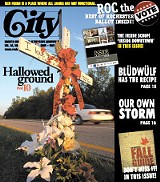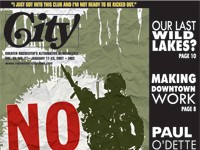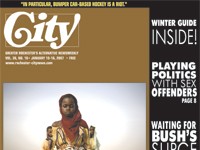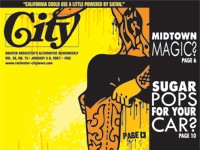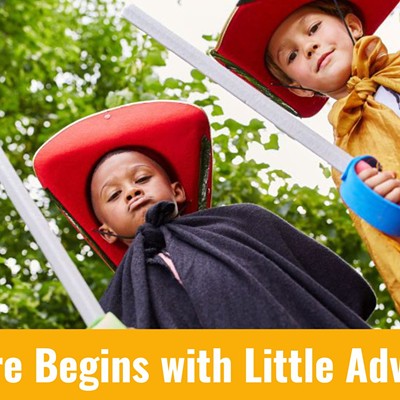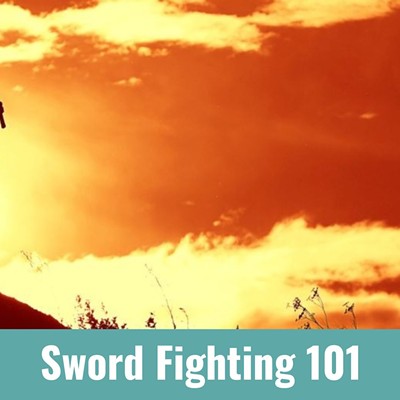[
{
"name": "500x250 Ad",
"insertPoint": "5",
"component": "15667920",
"parentWrapperClass": "",
"requiredCountToDisplay": "1"
}
]
7 p.m Wednesday, March 30, 2005: 17-year-old DeMario Moore, walking home in the northwest section of the city after playing basketball, stops to talk to a girl he knows from school. They don't talk long, but when Moore walks away, he is shot in the back by the girl's boyfriend. Moore is dead before the ambulance arrives.
"He didn't run," recalls his mother Sharon Moore. "My boy didn't even know what happened to him."
By late that evening, classmates, neighbors, friends, even total strangers are placing small mementoes along the wooden fence at the corner of Wilson near North. Candles, pictures, poems, stuffed animals, T-shirts, a football, incense, and flowers stretch the length of the fence. Several crosses, some merely two boards nailed together, are planted in the ground. The nearly 30-foot-long memorial, with the mementos delicately pieced together, reaches several feet high.
A disgusted Sharon Moore talks about the young man who killed her son --- an acquaintance who had been at DeMario's birthday party just 15 days earlier. "One of these little street rats we got hanging' around here with no future," says Moore. "Nowhere to go."
"He had no future so he takes my son's," she says, shaking her head. "People loved DeMario," says Moore. "He was a pretty boy. He loved football. The boy loved anything to do with sports, but he really loved football. He was an honor student, and he said he wanted to go to school to learn how to design his own clothing line. He always had lots of ideas.
"But I thought he should do something in health care," says Moore, "or something working with people. He loved working with older people, and they all loved him."
Moore says she is comforted by the neighborhood memorial, grateful that so many people cared enough to leave something in his memory.
"I feel like he is closer to us when I see it," she says. "I feel like he could come walkin' around the corner at any moment. He would like it, too. It shows you just how popular he was. He touched so many people in such a short time."
They appear along roadsides in the country, at busy city intersections, on interstate highways, and deep inside residential neighborhoods. They stand among the weeds, guard rails, and rubber sheathing of blown tires. At first glance, they seem awkward and out of place, like Christmas ornaments in the middle of summer. Ruby red silk flowers fade to rose. Patriotic ribbons fray in the wind. Crosses lean into hillsides. These makeshift memorials mark the intersection between two worlds, before and after, heaven and earth. In almost every case, they speak about life and loss in a way that is both macabre and beautiful.
Roadside memorials are found all over the world. They're in Ukraine and Utah. They're common in South and Latin America, countries where Catholicism has mixed with the beliefs of indigenous people. In Mexico, they're called descansos:rest. And while they are not as common in the northeast as they are in the southwestern US, more seem to appear here every year. Those found on highways are almost entirely the result of vehicular accidents, many involving alcohol. Memorials found in neighborhoods tend to be the result of street violence involving handguns.
One thing they all seem to have in common: They appear to be a reference to young people taken unexpectedly and prematurely, the loss of innocence.
10 p.m., Monday, July 13, 2003: 22-year-old Michael Coyle calls his father to say he is on his way to pick up his girlfriend, Jessica Lynn Piurkoski. As they head west across the IrondequoitBayBridge, another car, eastbound in the wrong lane, crashes into them. The head-on collision claims all three lives.
Michael Coyle was "a romantic," says his father, also named Michael. "A good-looking kid. A loving kid. He would have been 25 this November."
"He was a free spirit," says Coyle, "and he had girls. Oh, gosh, he had girls around him for years. But he wasn't serious until he met Jess. He told me once, 'Dad, I think she's the one. I think I'm in love.' We laughed about it a little, but I think he really did care for her, and sometimes I wonder what would have happened if they had lived. Where would they be today?"
Until a few years ago, the senior Coyle lived in Hamlin with his wife and their three children. He describes a 10-year period of bad luck that left him divorced. And just when things seemed like they couldn't get any worse, he lost his son.
"I knew what that experience was like, because my brother died of cancer," he says, "and that was hard, especially on my father. I remember him saying to me that it was so unfair. It just seemed wrong to him to be burying his child. And here I ended up going through the same thing. And he was right; it was the most horrible experience I've ever known."
Coyle says he can't be angry at the driver of the other car, even though there were reports that alcohol may have contributed to the crash. "What good does it do?" he asks. "For a while, I was angry, but now I just think it was too bad for all of them. There's no way to explain it. For a long time, I kept asking myself: Why my son? But there's just no answer to things like that."
Almost immediately, Jessica and Michael's friends began putting a memorial together on the bridge. As word got around, more items were added. Although two years have passed, it's not unusual to see the site freshened up with new flowers and stuffed animals. Coyle checks the site regularly and is sometimes its caretaker.
"His mother called me up a little while ago. She won't go by it. But she calls me up and said that so and so told her one of the crosses was coming down. Would I go fix it up? And of course, I did. I stop by every now and then. Even though I know he's not buried there, I feel closer to him there. I'm drawn to it. I have some kind of connection to it."
"Sometimes I just want people to know how great a kid he was," says Coyle. The accident "made headlines for a few days," he says, "and then it was over. And I just want people to remember. He's still a part of me. He'll always be a part of our lives."
And Coyle says he is grateful for one thing: He learned how to express his feelings for his son. "Don't get me wrong," he says. "We had our share of problems. But even though he went from being a boy to a grown man, we still hugged, and I told him I loved him. He was like that, too. He would still hug me. Even if you have problems with your kids, man, never forget to tell them you love them. I thank God for that every day."
A car pulled up and stopped in front of Mary McCluz's house on East Main Street on a clear Sunday morning in April two years ago. Several women, dressed as if they were just returning from church, got out and began to clear away the base of a tree next to the curb. One of the women worked on her hands and knees; the others stuffed debris into plastic trash bags. An hour later, a bed of artificial flowers circled the base. Huge white and yellow stuffed animals were tied to the trunk. And as the women stood around the tree; one kissed her hand, then pressed it against the bark.
McCluz doesn't know the women. And she doesn't know about an accident at that site. But she doesn't mind the attention the memorial gets. The women visit the tree from time to time. And between visits, if the memorial looks a little shabby, McCluz herself goes out and spruces up the site for them.
"I know whatever it was, it made them terribly sad," she says. "They're not from around here, so I thought it might make them feel a little better if they knew someone else was helping them take care of it. It's the least I can do. If somebody is that tore up inside, you know they need a little help."
Reactions to roadside memorials vary. Some people see them as art. Ansel Adams' riveting "Moonrise, Hernandez, New Mexico" (1941) is, according to some experts, the most sought-after fine-art photograph ever taken. A roadside cemetery next to an adobe hut, the moon suspended above a drift of clouds: The work suggests an image of heaven and earth. And it captures the essence of roadside memorials with uncanny perception.
Other people find memorials disturbing or unsightly. The original memorial to DeMario Moore was abruptly collected and carted away by city workers. When friends and neighbors complained, however, the destruction caught the attention of Mayor Bill Johnson.
"He came down here himself and apologized," says Sharon Moore. "He said it was a mistake and it wouldn't happen again. We were free to put the memorial back if we wanted to." Areplacement now stands on Wilson Street.
In contemporary American society, outwardly mourning the loss of a loved one has become less visible. "We have a great deal of exposure to death through the media," says Christine Bochen, professor of religious studies at NazarethCollege, "but as a people, it is unfamiliar to us. And I see these memorials as an expression of that grief."
"As a society, we have seen a decline in the symbols of mourning," says Bochen. "Years ago, one would wear black clothing to mark the event and to tell others that one is in mourning, and I think the memorials take on two roles: One is to memorialize the loved one and to ask others to remember this person we loved, and the other is to communicate a message, to tell a story."
Bochen has been teaching a class on death and dying for more than 10 years.
"Acts like these are spontaneous and unconventional," she says. "The sites can seem primitive. And I have noticed over the years of teaching this class that we are often talking about the resilience of the human spirit."
"Death is really about living," says Bochen. And she notes how Americans' perspective about death has changed over the last 20 years. "The right to die through assisted suicide, the resistance to the death penalty, the whole integration of hospice being seen as a part of end-of-life treatment: These things are relatively new," she says. "And I think the roadside memorials are a reflection of that trend."
2:30 a.m., Thursday, July 29, 2005: Benjamin Howe, age 22, loses control of his car on the Lake Ontario Parkway. He may have dodged a deer. Maybe he just dozed off at the wheel.
"Short in stature, but big in presence. The loud one in the group: That was Ben," says his mother, Sharyn Howe. "He loved wrestling, and it was kind of funny to see little Ben horsing around with these big guys. Come Monday night, you always knew where Ben was. That was wrestling night."
"He was sensitive, too," says his sister Maegan. "Nothing bothered him more than racism. He hated it, and he wasn't afraid to let you know it, either. He wasn't afraid of anything --- except spiders." Maegan laughs, remembering her brother.
All she has ever wanted from life, says Sharyn Howe, was to know that her kids were happy, healthy, good people. And she never thought about Ben dying. "It never once entered my mind," she says. "Ben was so full of life."
Howe and her daughter smile, talking about Ben. "He would probably love all this attention," says Howe. "He would go into a department store and pretend he was lost just so they would call out over the loud speaker." Sometimes Ben himself would speak into the microphone. "And of course, he wasn't lost," says Howe. "He just loved hearing his own voice. Oh, I would be so embarrassed. He was a handful, but he was never dull."
Sharon Howe's sister, Patty Haines began putting together the roadside memorial for her nephew. She had seen other memorials, and this seemed a way both to honor Ben and to help the family through a difficult time.
Ben's memorial consists of two crosses, one poised on each side of the Parkway. "There was some confusion as to where the accident actually occurred," says Haines, "because there aretire marks where you can see how the car went across the highway to the other side. That's why there is more than one cross. We really don't know all the details of what happened. They say it was excessive speed. But it was his father's '62 Subaru, and you really couldn't drive too fast in that car because it would start to shake."
Haines doesn't find memorials depressing. "And it is not a religious statement," she says. "I think they're beautiful. We just want people to know that we lost someone precious here. And if people read a message into it and think maybe they should drive a little more cautiously, that's fine. It could help someone else's family."
Latest in Featured story
More by Tim Louis Macaluso
-

RCSD financial crisis builds
Sep 23, 2019 -
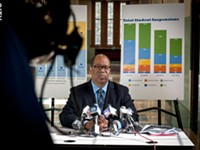
RCSD facing spending concerns
Sep 20, 2019 -

Education forum tomorrow night for downtown residents
Sep 17, 2019 - More »
